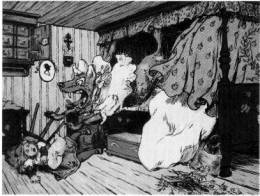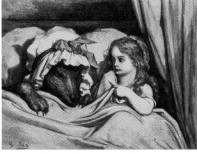
|
LITR 4533: |
|
|
Genre Presentation 2004 |
A Fairy Tale – What
Really Happened…
By Carole White

Definition:
“ a short narrative derived from the oral tradition of the folk tale, involving such figures as witches, giants, fairies, …princes (sometimes miraculously transformed from frogs), princesses (usually in distress), and stepmothers (regularly cruel). [They also] invariably suggests that good triumphs over evil, an important moral function.”
Beckson, Karl and Arthur Ganz. Literary Terms: A Dictionary. New York: Farrar, Straus and Giroux, 1989.
Examples:
“Little Red Riding Hood,” by Charles Perrault (1697)
In the end the wolf “threw himself on Little Red Riding Hood and gobbled her up.” (read excerpt)
“Little Red Riding Hood,” by Brothers Grimm (1857)
The wolf “went straight to Grandmother’s bed and gobbled her right up. Then he put on her clothes and her nightcap, lay down in her bed, and drew the curtains.”
“No sooner had the wolf said these words than he leaped out of bed and gobbled up poor Little Red Riding Hood.”
The huntsman comes to save the day by performing a caesarian section on the wolf to free the grandmother and Little Red Riding Hood and fills the belly of the wolf with stones.
“The Story of Grandmother,” by Louis and Francois Briffault (1885) (read example)
“Little Red Riding Hood,” by Tracy Maroney (1999) (read example)

Genre:
Fairy Tale
Representational Genre:
Narrator and Dialogue
The stories usually start with a Narrator saying, “Once Upon A Time…” and then the narrator will set the scene and the dialogue of the character will take over until all is resolved or the action ceases in which the Narrator will cue back in to sum up the story.
Narrative Genres:
Tragedy: The eating of or the death of Little Red Riding Hood and her Grandmother
Comedy: Mistaken identity of the wolf. In Grimm’s and Moroney’s versions there is a sense of a group hug at the end (unity).
Satire: As in Briffault’s adaptation they take the original story and mock the underlying sexuality of it.
Romance: Little Red Riding Hood goes on a journey. In some of the stories she is rescued by a woodman and she lives happily ever after as she overcomes the evil wolf.
Related Genre:
Fantasy, Parable, Fable, Folk tale
Audience Appeal:
Meant for children, however stories have changed to be parent/child friendly. Despite the graphic, violent, and sexual nature to some of the older versions they were “deemed acceptable because they instruct children through explicit warnings and lessons, even though some of the implicit messages may be harmful to children. Most of the great pedagogical debates center around the brutality and cruelty in some tales, and the tendency among publishers and adapters of the tales has been to eliminate the harsh scenes.” (Zipes, 49).
Previous Presentations:
Sami Cantwell (2000)- Definition of fairy tale- “struggles over voice, storytelling, and the socialization of children…literary fairy tales were complex symbolic social acts intended to reflect upon norms, and habits organized for the purpose of reinforcing a hierarchically arranged civilizing process in a particular society" – Jack Zipes, Happily Ever After: Fairy Tales, Children, and the Cultural Industry, New York, Routledge, 1997.
Other
Examples: (of how fairy tales have changed)
Cinderella’s wicked stepsisters actually get their eyes pecked out by birds.
The Little Mermaid sees the man she loves marry another woman and then drowns herself, so yes, she dies.
Snow White might actually have a little Electra Complex going on.
Questions:
Do you think the original Perrault or Grimm story is too violent or graphic for children?
Why do you think the stories have been altered? How has the sensitivity of people changed over time? Have we lost anything important by changing the stories?
What sexual elements can be seen in the original Perrault and Grimm versions of the tale?
Can you think of any other stories that have been changed to be more audience friendly?
Works
Cited:
Maroney, Tracey. Little
Red Riding Hood. Chicago:
Learning Curve, 1999.
Tatar, Maria. The Annotated Classic Fairy Tales.
‘“Little Red Riding Hood,’ by Jacob and Wilhelm Grimm.”
New York: W.W. Norton &
Company, 2002. 17-27.
Tatar, Maria. The Annotated Classic Fairy Tales.
‘“The Story of Grandmother,’by Louis and Francois Briffault.”
New York: W.W. Norton &
Company, 2002. 369-370.
Tatar, Maria. The Annotated Classic Fairy Tales.
‘“Little Red Riding Hood,’ by Charles Perrault.”
New York: W.W. Norton &
Company, 2002. 371-373.
Zipes, Jack. The Brothers Grimm: From Enchanted Forests to the Modern World. New York: Palgrave MacMillan, 2002.
